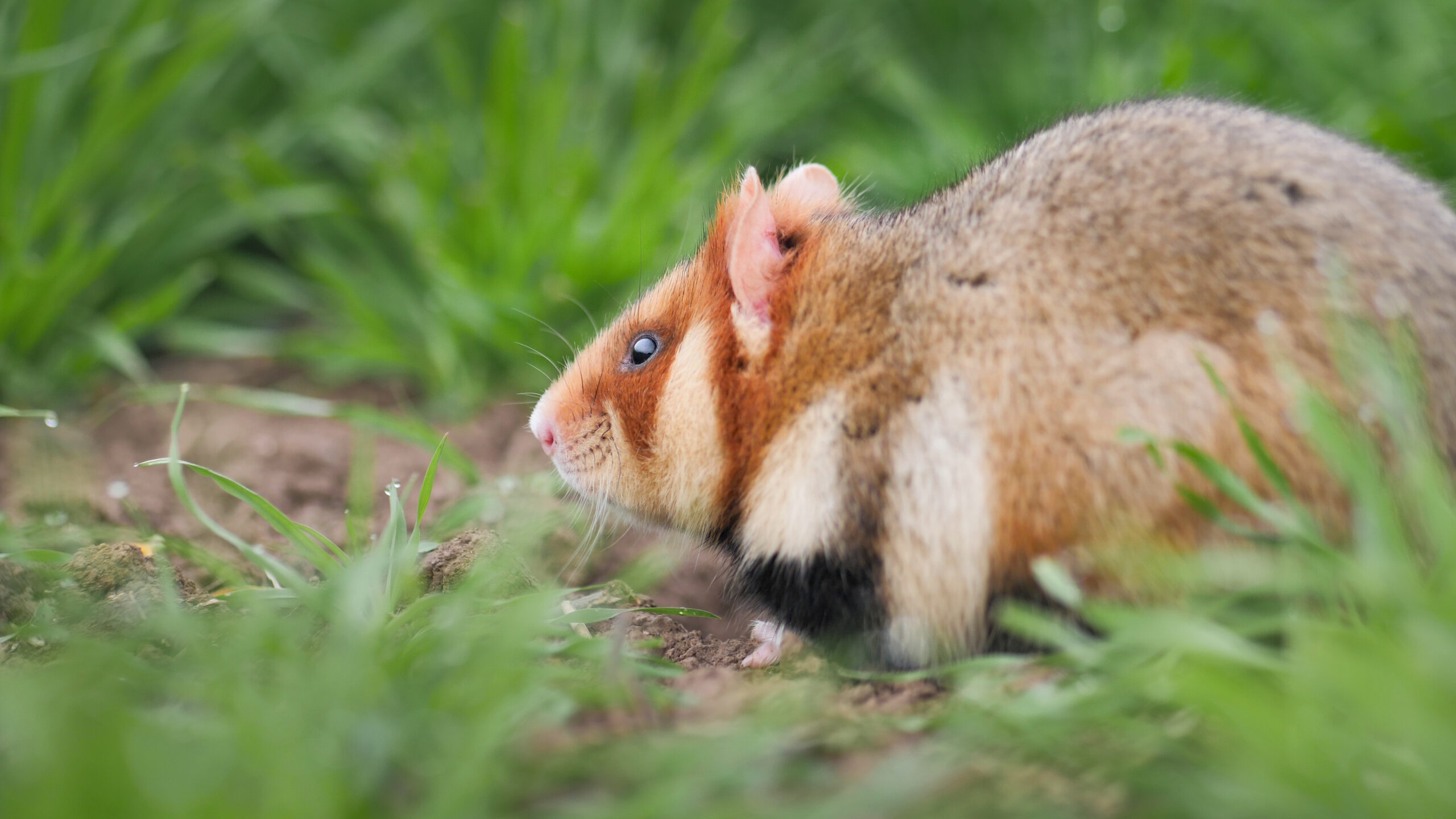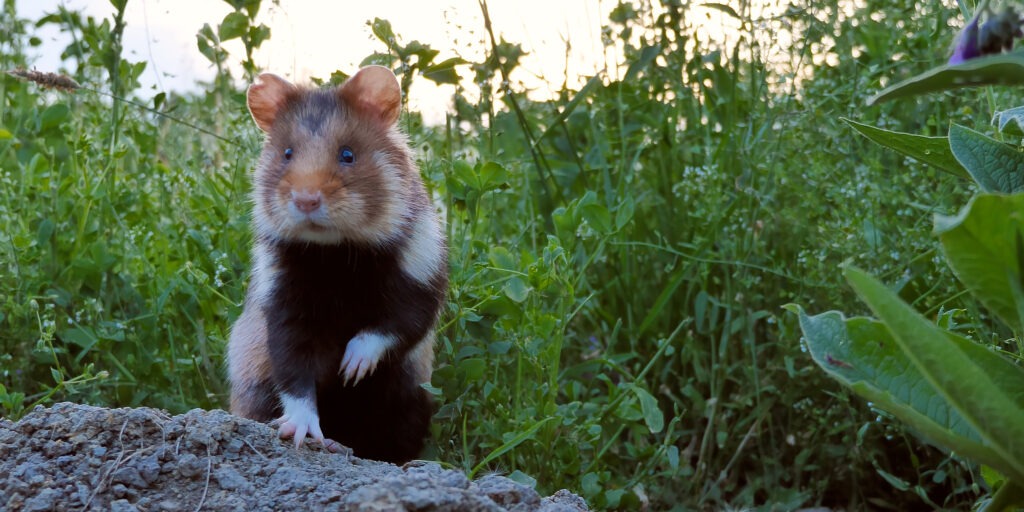As a synanthrope the Common hamster was only able to spread as much as it did because of human agriculture. Up until the 1980s, it was considered a crop pest and, hence was hunted and poisoned. The fact that the species is now threatened with extinction dramaticly highlights the impact of intensified agriculture on species who thrive in open land. Many causes of death of the Common hamster are either directly or indirectly related to modern agriculture.
The structure of agricultural land
Intensified agriculture has a negative impact on the habitat of the Common hamster. Due to the switch from summer to winter grain harvest is conducted much earlier. This leads to an abrupt loss of cover from predators. It is common to harvest very flat on the ground and also to plow under the stubble soon after harvest. This means that there is no retreat for the European hamster. If there are no hedges, young fallow land or field strips, the Common hamster becomes an easy prey for birds of prey or foxes. As a result of effective harvesting techniques, the Common hamster loses its food just as suddenly. Often it not only lacks the opportunity to get through a second or even a third litter, but also to build up sufficient supplies for the winter. Monocultures have drastic consequences, because on the one hand the important food is missing in spring after hibernation and on the other hand the fields lie fallow after the corn harvest in autumn, for example. The hamster is also threatened by the use of pesticides and rodent poisons in its habitat.
Other human influences
Our cultural landscape is increasingly shaped by traffic. The fragmentation of habitats by infrastructure makes genetic exchange more difficult and leads to drastic isolation of the last remaining populations. Crossing the street is another cause of death. Habitats disappear completely as a result of the sealing of surfaces.
Common Agricultural Policy
Significant structures of agriculture are specified by the common EU agricultural policy (CAP). In a statement, several science academies pointed out the diverse causes of the decline in biodiversity and, in this context, developed recommendations for a revision of the CAP. At present, the CAP focuses, among other things, on increasing yields and has a correspondingly negative effect on biodiversity. However, funding conditions at EU level in particular could be a useful instrument for strengthening biodiversity.
For example, incentive compensation in the form of financial compensation to farmers for measures to promote biodiversity (depending on the soil quality) would be important. In the film project “The Last European Hamsters” we investigate this topic with interviews. We show agricultural land as a habitat and also the effects of modern agriculture. The educational work goes beyond the concrete situation of the European hamster. As a species with high reproductive potential, which is nevertheless on the verge of extinction, the case of the Common hamster offers a critical approach to the state of our agriculture.
Protection status of the European hamster
The Common hamster is in danger of extinction. In Germany’s Red List, this classification is linked to a particularly high degree to Germany’s responsibility. According to the Habitats Directive, the Common hamster is one of the protected animal species (FFH Directive EG 2013/17, Annex: IV). It is also listed as a strictly protected species in Appendix II of the Bern Convention (92/43/EEC, Appendix II) and is therefore also strictly protected by the Federal Nature Conservation Act (§7 Para. 2 No.14b BNatSchG). The IUCN consideres the species as criticallesy endangered worldwide. There is an urgent need for action to protect the Common hamster.
- In Germany (Rote Liste 2020)
- Red List Category 1 Critically Endangered
- Current stock situation: very rare
- Long-term population trend: very sharp decline
- Short-term population trend: strong decrease
- Extinct in: Brandenburg, Berlin, Baden-Württemberg, Hamburg, North Rhine-Westphalia
- Germany is particularly responsible
- individual risk factors: Increased direct impact, fragmentation/isolation, future resettlement is consicered very difficult
- Worldwide (IUCN 2020)
- Critically Endangered
- Short-term trend: decline
Literature
Banaszek, A., Bogomolov, P., Feoktistova, N., La Haye, M., Monecke, S., Reiners, T. E.,Rusin, M., Surov, A., Weinhold, U. & Ziomek, J. 2020. Cricetus cricetus. The IUCN Red List of Threatened Species 2020: e.T5529A111875852. https://dx.doi.org/10.2305/IUCN.UK.2020-2.RLTS.T5529A111875852.en
Jaschinsky, S., Weiss, A. (2020): Konstruktive Zusammenarbeit zwischen Artenschützern und Landwirtschaftsbetrieben – Perspektiven für den Feldhamsterschutz in Thüringen. Naturschutz und Landschaftsplanung 52 (8), 362-367.
Kayser, A., Weinhold, U. & Stubbe M. (2003): Mortality factors of the common hamster Cricetus cricetus at two sites in Germany. – Acta Theriologica 48 (1): 47-57.
Meinig, H.; Buschmann, A.; Reiners, T .E.; Neukirchen, M.; Balzer, S. & Petermann, R. (2014): Status des Feldhamsters (Cricetus cricetus) in Deutschland. – Natur und Landschaft 89 (8): 338–343.
O’Brien (2015): Saving the common hamster (Cricetus cricetus) from extinction in Alsace (France): potential flagship conservation or an exercise in futility?. Hystrix, 26(2). (abgerufen am 16.10.2020)
Out, M. J.; Van Kats, R. J. M.; Kuiters, L.; La Haye, M. J. J. u. Müskens, G. D. J. M. (2011): Hard to stay under cover: seven years of crop management aiming to preserve the common hamster (Cricetus cricetus) in the Netherlands. Säugetierkdl. Inf. 8 (42): 37–49.
Surov, A., Banaszek, A., Bogomolov, P., Feoktistova, N. and Monecke, S. (2016): Dramatic global decrease in the range and reproduction rate of the European hamster Cricetus cricetus. Endangered species research, 31, 119-145. (abgerufen am 15.10.2020)

